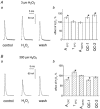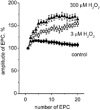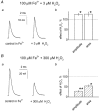Dual action of hydrogen peroxide on synaptic transmission at the frog neuromuscular junction
- PMID: 12897166
- PMCID: PMC2343314
- DOI: 10.1113/jphysiol.2003.050690
Dual action of hydrogen peroxide on synaptic transmission at the frog neuromuscular junction
Abstract
There is evidence that reactive oxygen species (ROS) are produced and released during neuromuscular activity, but their role in synaptic transmission is not known. Using a two-electrode voltage-clamp technique, at frog neuromuscular junctions, the action H2O2 on end-plate currents (EPC) was studied to determine the targets for this membrane-permeable ROS. In curarized or cut muscles, micromolar concentrations of H2O2 increased the amplitude of EPCs. Higher (> 30 microM) doses inhibited EPCs and prolonged current decay. These effects were presynaptic since H2O2 did not change the amplitude or duration of miniature EPCs (although it reduced the rate of spontaneous release at high concentrations). Quantal analysis and deconvolution methods showed that facilitation of EPCs was due to increased quantal release, while depression was accompanied by temporal dispersion of evoked release. Extracellular recordings revealed prolonged presynaptic Ca2+ entry in the presence of high H2O2. Both low and high H2O2 increased presynaptic potentiation during high-frequency stimulation. Pro-oxidant Fe2+ did not affect facilitation by low doses of H2O2 but augmented the inhibition of EPCs by high H2O2, indicating involvement of hydroxyl radicals. High Mg2+ and the ROS scavenger N-acetylcysteine eliminated both the facilitatory and depressant effects of H2O2. The facilitatory effect of H2O2 was prevented by protein kinase C (PKC) inhibitors and 4beta-phorbol 12-myristate, 13-acetate (PMA), an activator of PKC. PKC inhibitors but not PMA also abolished the depressant effect of H2O2. Our data suggest complex presynaptic actions of H2O2, which could serve as a fast feedback modulator of intense neuromuscular transmission.
Figures








Similar articles
-
Reactive oxygen species contribute to the presynaptic action of extracellular ATP at the frog neuromuscular junction.J Physiol. 2005 May 15;565(Pt 1):229-42. doi: 10.1113/jphysiol.2005.084186. Epub 2005 Mar 17. J Physiol. 2005. PMID: 15774519 Free PMC article.
-
Action of Hydrogen Peroxide on Synaptic Transmission at the Mouse Neuromuscular Junction.Neuroscience. 2019 Feb 10;399:135-145. doi: 10.1016/j.neuroscience.2018.12.027. Epub 2018 Dec 26. Neuroscience. 2019. PMID: 30593920
-
Opposite modulation of time course of quantal release in two parts of the same synapse by reactive oxygen species.Neuroscience. 2011 Aug 25;189:93-9. doi: 10.1016/j.neuroscience.2011.05.033. Epub 2011 May 26. Neuroscience. 2011. PMID: 21627983
-
The pharmacological effects of cadmium on skeletal neuromuscular transmission.Gen Pharmacol. 1994 Dec;25(8):1729-39. doi: 10.1016/0306-3623(94)90379-4. Gen Pharmacol. 1994. PMID: 7721053 Review.
-
Fatigue at the neuromuscular junction. Branch point vs. presynaptic vs. postsynaptic mechanisms.Adv Exp Med Biol. 1995;384:83-100. Adv Exp Med Biol. 1995. PMID: 8585479 Review.
Cited by
-
Gender-Specific Mechanism of Synaptic Impairment and Its Prevention by GCSF in a Mouse Model of ALS.Front Cell Neurosci. 2011 Dec 12;5:26. doi: 10.3389/fncel.2011.00026. eCollection 2011. Front Cell Neurosci. 2011. PMID: 22180738 Free PMC article.
-
Reactive oxygen species contribute to the presynaptic action of extracellular ATP at the frog neuromuscular junction.J Physiol. 2005 May 15;565(Pt 1):229-42. doi: 10.1113/jphysiol.2005.084186. Epub 2005 Mar 17. J Physiol. 2005. PMID: 15774519 Free PMC article.
-
Regulation of neuronal development and function by ROS.FEBS Lett. 2018 Mar;592(5):679-691. doi: 10.1002/1873-3468.12972. Epub 2018 Jan 26. FEBS Lett. 2018. PMID: 29323696 Free PMC article. Review.
-
Reactive oxygen species alters the electrophysiological properties and raises [Ca2+]i in intracardiac ganglion neurons.Am J Physiol Regul Integr Comp Physiol. 2010 Jul;299(1):R42-54. doi: 10.1152/ajpregu.00053.2010. Epub 2010 May 5. Am J Physiol Regul Integr Comp Physiol. 2010. PMID: 20445155 Free PMC article.
-
Role of membrane cholesterol in spontaneous exocytosis at frog neuromuscular synapses: reactive oxygen species-calcium interplay.J Physiol. 2014 Nov 15;592(22):4995-5009. doi: 10.1113/jphysiol.2014.279695. Epub 2014 Oct 17. J Physiol. 2014. PMID: 25326454 Free PMC article.
References
-
- Barstad JA, Lilleheil G. Transversaly cut diaphragm preparation from rat. An adjuvant tool in the study of the physiology and pharmacology of the myoneural junction. Arch Int Pharmacodyn Ther. 1968;175:373–390. - PubMed
-
- Castonguay A, Lévesque S, Robitaille R. Glial cells as active partners in synaptic functions. Prog Brain Res. 2001;132:227–240. - PubMed
Publication types
MeSH terms
Substances
LinkOut - more resources
Full Text Sources
Miscellaneous

